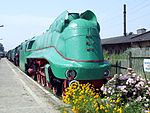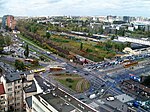Warszawa Główna railway station
Disused railway stations in PolandHistory of WarsawRailway stations closed in 1997Railway stations in WarsawRailway stations opened in 1938 ... and 1 more
Second Polish Republic

Warsaw Main Railway Station (Polish: Warszawa Główna) was the name of two different railway stations in Warsaw, Poland, both now defunct. A smaller terminus station with two platforms again named Warszawa Główna opened on March 14, 2021. The name was retained for historical reasons only, and the actual main station in Warsaw is Warszawa Centralna located about 1 km to the east.
Excerpt from the Wikipedia article Warszawa Główna railway station (License: CC BY-SA 3.0, Authors, Images).Warszawa Główna railway station
Kolejowa, Warsaw Wola (Warsaw)
Geographical coordinates (GPS) Address Phone number Website Nearby Places Show on map
Geographical coordinates (GPS)
| Latitude | Longitude |
|---|---|
| N 52.2263 ° | E 20.9871 ° |
Address
Stacja Muzeum
Kolejowa
00-965 Warsaw, Wola (Warsaw)
Masovian Voivodeship, Poland
Open on Google Maps











